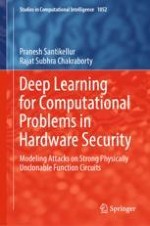2023 | OriginalPaper | Buchkapitel
5. Improved Modeling Attack on PUFs based on Tensor Regression Network
verfasst von : Pranesh Santikellur, Rajat Subhra Chakraborty
Erschienen in: Deep Learning for Computational Problems in Hardware Security
Verlag: Springer Nature Singapore
Aktivieren Sie unsere intelligente Suche, um passende Fachinhalte oder Patente zu finden.
Wählen Sie Textabschnitte aus um mit Künstlicher Intelligenz passenden Patente zu finden. powered by
Markieren Sie Textabschnitte, um KI-gestützt weitere passende Inhalte zu finden. powered by
